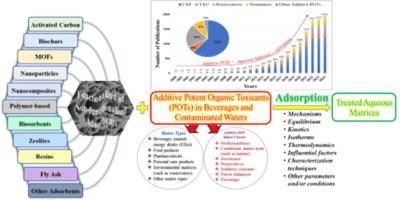吸附去除饮料和污染水中的强效有机毒物:吸附剂材料、动力学、等温线、热力学、机理和未来展望的综述
IF 9
1区 工程技术
Q1 ENGINEERING, CHEMICAL
引用次数: 0
摘要
在全球范围内,含添加剂的强效有机毒物,特别是能量饮料,由于其不断增加的产量、超过建议水平的过量摄入以及排放到水生生态系统中,已经引起了重大的健康和环境问题。这些添加剂包括甜味剂、咖啡因、牛磺酸、防腐剂、调味剂和合成着色剂等,被认为是新兴的有机污染物(EOCs),经常在各种水体中被检测到,从而对人类健康和生态系统构成风险。应对这些挑战需要开发创新和有效的补救策略,新的吸附材料和方法由于其成本效益、效率、环境兼容性和简单性而成为一种有前途的方法。尽管对水介质中饮料添加剂POTs的吸附去除进行了大量的研究,但专门针对不同吸附材料应用的批评性评论仍然有限。因此,本文旨在批判性地分析最近的研究,主要是过去十年来关于使用不同吸附剂从饮料和污染水中分批吸附去除添加剂罐的研究。综述了各种吸附剂材料在饮料添加剂中去除POT的应用、动力学、等温线和热力学研究,以及物理吸附和化学吸附等吸附机理。它还讨论了影响吸附的关键因素,同时评估了对人类健康的毒理学影响。最后,本综述强调了添加剂吸附法修复的当前挑战和未来前景,强调需要可持续、创新的吸附技术,以确保更安全的饮料和改善的水质,并与关注负责任消费、食品安全、健康和清洁水的可持续发展目标(sdg)保持一致。本文章由计算机程序翻译,如有差异,请以英文原文为准。

Adsorptive removal of additive potent organic toxicants from beverages and contaminated waters: A critical review of adsorbent materials, kinetics, isotherms, thermodynamics, mechanisms, and future prospects
The global consumption of additive potent organic toxicants (POTs) in ergogenic beverages, particularly energy drinks (EDs), has raised significant health and environmental concerns due to their increasing production, excessive intake beyond recommended levels, and discharge into aquatic ecosystems. These additive POTs, which include sweeteners, caffeine, taurine, preservatives, flavorings, and synthetic colorants among others, are recognized as emerging organic contaminants (EOCs) and are frequently detected in various water bodies, thus posing risks to human health and ecological systems. Addressing these challenges requires the development of innovative and effective remediation strategies, with new adsorption materials and methods emerging as a promising approach owing to its cost-effectiveness, efficiency, environmental compatibility, and simplicity. Despite considerable research on the adsorptive removal of beverage additive POTs from aqueous media, critical reviews focusing specifically on the application of different adsorbent materials remain limited. Therefore, this article aims to critically analyze recent studies primarily from the past decade on the batch adsorption-based removal of additive POTs from beverages and contaminated waters using diverse adsorbents. The review provides a critical examines the application of various adsorbent materials for beverage additive POT removal, the kinetic, isotherm, and thermodynamic studies, as well as the adsorption mechanisms, such as physisorption and chemisorption. It also discusses key factors influencing adsorption, alongside an assessment of the toxicological implications for human health. Finally, the review highlights current challenges and future prospects in the additive POT remediation, emphasizing the need for sustainable, innovative adsorption technologies to ensure safer beverages and improved water quality, in alignment with the Sustainable Development Goals (SDGs) focused on responsible consumption, food security, health, and clean water.
求助全文
通过发布文献求助,成功后即可免费获取论文全文。
去求助
来源期刊

Separation and Purification Technology
工程技术-工程:化工
CiteScore
14.00
自引率
12.80%
发文量
2347
审稿时长
43 days
期刊介绍:
Separation and Purification Technology is a premier journal committed to sharing innovative methods for separation and purification in chemical and environmental engineering, encompassing both homogeneous solutions and heterogeneous mixtures. Our scope includes the separation and/or purification of liquids, vapors, and gases, as well as carbon capture and separation techniques. However, it's important to note that methods solely intended for analytical purposes are not within the scope of the journal. Additionally, disciplines such as soil science, polymer science, and metallurgy fall outside the purview of Separation and Purification Technology. Join us in advancing the field of separation and purification methods for sustainable solutions in chemical and environmental engineering.
 求助内容:
求助内容: 应助结果提醒方式:
应助结果提醒方式:


